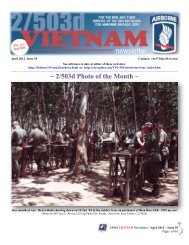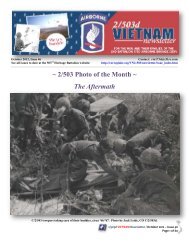OPERATION MACARTHUR, THE BATTLES AT DAK TO - Corregidor
OPERATION MACARTHUR, THE BATTLES AT DAK TO - Corregidor
OPERATION MACARTHUR, THE BATTLES AT DAK TO - Corregidor
Create successful ePaper yourself
Turn your PDF publications into a flip-book with our unique Google optimized e-Paper software.
By early October, U.S. intelligence reported that the<br />
North Vietnamese were withdrawing regiments from the<br />
Pleiku area to join those in Kontum Province, thereby<br />
dramatically increasing the strength of local forces to<br />
that of a full division. In response, the 4th Infantry<br />
began moving the 3rd Battalion, 12th Infantry and the<br />
3rd Battalion, 8th Infantry into Đắk Tô to launch<br />
Operation MacArthur. On 29 October, the 4/503 of the<br />
173d Airborne Brigade was returned to the area as a<br />
reinforcement. The battalion was moved west of Đắk Tô<br />
to the CIDG camp at Ben Het to protect the construction<br />
of Fire Support Base 12 on 2 November.<br />
On 3 November, Sergeant Vu Hong, an artillery<br />
specialist with the 6th PAVN Regiment, defected to the<br />
South Vietnamese and was able to provide U.S. forces<br />
with detailed information on the disposition of PAVN<br />
forces and their objectives, both at Đắk Tô and at Ben<br />
Het, 18 kilometers to the west. The North Vietnamese<br />
had fed approximately 6,000 troops into the area, most<br />
of which made up the 1st PAVN Division. The 66th<br />
PAVN Regiment was southwest of Đắk Tô preparing to<br />
launch the main attack while the 32nd PAVN Regiment<br />
was moved south to prevent any counterattacks against<br />
the 66th. The independent 24th PAVN Regiment held<br />
positions northeast of Đắk Tô to prevent reinforcement<br />
of the base from that direction. The 174th PAVN<br />
Regiment was northwest of Đắk Tô, acting as a reserve<br />
or an offensive force as the situation dictated. In<br />
addition, the 1st PAVN Division was supported by the<br />
40th PAVN Artillery Regiment. The goal of these units<br />
was the taking of Đắk Tô and the destruction of a<br />
brigade-size American unit.<br />
Brigadier General Leo H. Schweiter, commander of the<br />
173d Airborne Brigade<br />
~ Prelude ~<br />
Major General William R. Peers, commander of the 4th<br />
Infantry Division and overall U.S. commander at Đắk Tô<br />
The communist actions around Đắk Tô were part of<br />
an overall strategy devised by the Hanoi leadership,<br />
primarily that of General Nguyen Chi Thanh. The goal<br />
of operations in the area, according to a captured<br />
document from the B-3 Front Command, was "to<br />
annihilate a major U.S. element in order to force the<br />
enemy to deploy as many additional troops to the<br />
Central Highlands as possible." As the Americans<br />
quickly discovered, the area had been well prepared by<br />
the North Vietnamese. The number and elaborateness of<br />
defensive preparations found by U.S. and ARVN troops<br />
indicated that some had been prepared as much as six<br />
months in advance. As General Peers noted:<br />
Nearly every key terrain feature was heavily fortified<br />
with elaborate bunker and trench complexes. He had<br />
moved quantities of supplies and ammunition into the<br />
area. He was prepared to stay.<br />
After contact with the PAVN forces on the 4th and<br />
5th of the month, General Schweiter received orders to<br />
move the rest of his brigade back to Đắk Tô. The<br />
immediate goal of the paratroopers was first to establish<br />
a base of operations and bolster the defenses at Ben Het.<br />
They would then begin to search for the headquarters of<br />
the 66th PAVN Regiment, which U.S. intelligence<br />
believed to be in the valley stretching south of FSB 12.<br />
Simultaneously, most of the remaining elements of the<br />
4th Infantry Division moved into the area around Đắk<br />
Tô. They were joined by two First Air Cavalry<br />
battalions (the 1/12 and 2/8th Cavalry) and ARVN<br />
forces consisting of the four battalions of the 42nd<br />
Regiment and the 2nd and 3rd Airborne Battalions. By<br />
this time, the village and airstrip had become a major<br />
logistical base, supporting an entire U.S. division and<br />
airborne brigade and six ARVN battalions. The stage<br />
was set for a major pitched battle.<br />
2/503d VIETNAM Newsletter / November 2012 – Issue 47<br />
Page 4 of 125
















